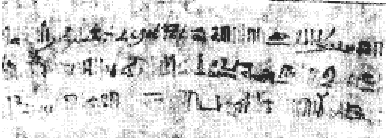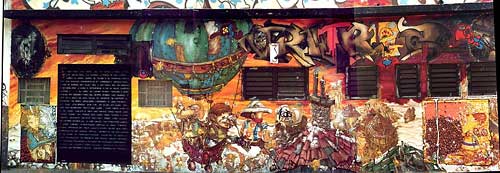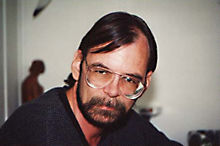

Published for The Neotrope Enterprise. Publisher: Bengt Rooke. September 2001. No. 26.
A BRIEF HISTORY OF GRAFFITI RESEARCH
STAFFAN JACOBSON
Ph.D.

The first graffito made 3.500 years ago at Sakkara, Egypt,

and one of the latest: Os Gemeos from Sao Paolo, Brazil.
A) Traditional Graffiti
The very first graffito was probably made 3.500 years ago by an ancient tourist near the Sakkara Pyramid; it reads, with scribbled hieroglyphs: ”I am very impressed by Pharaoh Djosers´ pyramid.”
Graffiti have become a common every day life phenomenon especially since the days of Ancient Greece. The Vikings, too, left graffiti names with runes from England to Constantinople.
Graffiti research, however, is more modern.
The first centuries of graffiti research 1600-1800 focus on two Italian issues: The catacombs of Rome and the excavated city of Pompeii.
The term ”graffiti” is introduced and the methods in use are mainly archeological. Cultural values, not moral ones, are the main interests of this research.
1593
The catacombs of Rome were built during the 1st and 2nd centuries A.D., then forgotten and later rediscovered.
The first one to investigate graffiti in a serious way was the Italian Antonio Bosio. His ”Roma Sotteranea” was written in 1593, published in folio format in 1632 and contains a systematic description of official and non-official inscriptions in the catacombs of Rome, complete with maps of the ”secret tunnels”. Bosio also left his own signature in the Priscilla catacomb, but he never used the actual word ”graffiti”.
1731
”The Merry Thought”, published in London 1731 under the pseudonym Hurlo-Trumbo is a poetic record of scratchings on glass windows and privies, an early ”scratchiti” compilation more than an investigation.
Josef Kyselak (1795-1831) was notorious for writing his name “Kyselak” or “Kyselak war hier!” all over Austria-Hungary, many years before ”Kilroy”. During the French Revolution and the days of the Paris Commune there was a growth of political graffiti.
1856
The archeologist Raphael Garucchi was probably the first person to use the word graffiti when he researched the ”Graffiti de Pompéi” 1856.
His purpose was to divide official cursive inscriptions from common people’s inscriptions on ancient monuments in the city buried by the volcanic outburst of Vesuvius in the year 79. Pompeii was for a long time forgotten, rediscovered and plundered from 1748 and professionally excavated from 1860. Today 3/4 of the city can be seen.
1874
Withrow, W.H.: The Catacombs of Rome. Nelson & Phillips, N.Y. 1874. p. 59, 60, 130, 148, 174, 175. b/w ill.
In the first half of the 1900s scholars from two other disciplines arrive in this field: ethnographers and linguists. Graffiti are studied as a folkloristic language phenomenon, often with emphasis on the ”low” elements.
Collecting graffiti is the primary thing and there is still some lack of theory. During the Second World War and the following years a new kind of mobile graffiti appeared with the ”Kilroy was here” epidemic, and graffiti are now also seen as a communication code for uncensored personal needs, feelings and opinions.
1904
The work Anthropopytheia was published by F.S. Krauss in Leipzig as 10 yearbooks 1904-1914. Latrinalia etc are documented here and discussed from a folkloristic point of view.
1914
Calonne-Beaufaict, M. de: Les graffiti du Mont Gundu. Revue D’Etnographie et de Sociologie, No 3-4, Mars-Avril 1914, p. 109-117.
1935
The linguist Allen Walker Read published ”Lexical Evidence from Folk Epigraphy in Western North America” 1935, a field study of language in graffiti which had great wider influence.
1937
Helen Tanzer described ”The Common People of Pompeii” from graffiti examples.
1946
Article ”Transit Association Ships a Street Car to Shelter Family of ’Kilroy Was Here’ ”. The New York Times, Dec 24, 1946, p. 18. (On James J. Kilroy, Halifax, Massachusetts).
1947
Article ”Who Is 'Kilroy' ?” The New York Times Magazine, Jan 12, 1947, p. 30, (James J. Kilroy, Halifax, Massachusetts, in his own words on the origins of the “Kilroy was here” graffiti.)
1956
Brassai´s (Guyla Halasz, 1899-1984) photos of graffiti scratchings on house facades in Paris were shown at MoMA, N.Y. 1956-57.
1964
Brassai´s book ”Conversations avec Picasso” was first published by Gallimard, Paris 1964.
Jorn, Asger (ed.): Signes gravés sur les églises de L’Eure et du Calvados. Institut Scandinave de Vandalisme Comparé, København 1964.
In the latter part of the 20th century, we can see that, on the one hand, the earlier research traditions continue, dealing with the traditionally forms of graffiti.
The Maledicta journal in the USA, the Musée des Graffiti Historique in France, the Graffiti Archive in Kassel and the Institut für Graffiti-forschung in Vienna are some of the most prominent contributors to this research; the Art Brut museum in Lausanne should also be mentioned.
Violet Pritchard published English Mediaeval Graffiti in 1967, in 1976 Aron Sheon published ”The Discovery of Graffiti” on the history of the reception of traditional graffiti (Art Journal 1/1976, p. 16-22.)
Margit Etter did a study on Harald Naegelli’s spray drawings out of C.G. Jung: Spray Bilder in Zuerich: Eine psychologische Studie, 1979, and Martin Blindheim wrote Graffiti in Norwegian Stave Churches c: 1150-1350, Oslo 1985.
Helen Levitt wrote In the Street 1987 ; Christine Schiavo : A historical analysis of Political graffiti in Belfast and Derry,1988 ; in 1990 came John Bushnell: Moscow Graffiti and in 1993 Norbert Siegl: Kommunikation am Klo.
On the other hand, there is a new, urban kind of graffiti emerging, the aerosol art, and with it come in turn sociologists such as Castleman, Brewer and Ferrell (USA) and art historians such as Stahl (Köln), Stewart (N.Y), and Jacobson (Sweden).
Also, this form becomes for the first time subject for society concern, viewed as either a new art form or a new kind of nuisance, or maybe both.
Some graffiti scientists, such as Professor Peter Kreuzer in München and Dr Jack Stewart in N.Y, also deal with both traditional graffiti (TG) and tags/throw-ups/pieces (TTP).
1968
In the transition phase between TG and TTP during the turbulent late sixties we see researchers such as Robert Reisner, who gave the first university lectures on graffiti and published 4 compilation books 1967-1974 which gave TG an air of cultural entertainment, and French-American William McLean who in Encyclopaedia Universalis band 7, p. 849.854, Paris 1970, made the first theoretic scientific overview and wrote the history of graffiti up to 1968....
B) Tags/Throw-ups/Pieces.
....and Herbert Kohl, teacher and activist who carefully studied the embryos of TTP in his article ”Names, Graffiti and Culture” in Urban Review, April 1969, vol 3, nr 5, p. 25-37 and his book: ”Golden Boy as Anthony Cool.” A Photo Essay on Naming and Graffiti. Dial Press, N.Y. 1972, which built a very valuable base for further research.
1971
Article ”The Aerosol Autographers - Why They Do It” by Sandy Padwe in Philadelphia Inquirer Magazine, May 2, 1971, pp. 8-10, 12, 44 on the origins of TTP with interviews with Cornbread and friends, the first ”graffiti writers” ever.
Article ”Taki 183 Spawn Pen Pals” by Don Hogan Charles in The New York Times, July 21, 1971, p. 37 on Taki 183, Julio and the arrival of TTP in New York.
1973
Norman Mailer/Jon Naar/Mervin Kurlansky: The Faith of Graffiti. Alskog Publ. N.Y. 1973. An early photo record and essay.
1974
David Ley & Roman Cybrivsky : Urban Graffiti as Territorial Markers. Annals of the Association of American Geographers, Vol. 64, nr 4/1974, p. 491-505.
Qualified and unusual thesis which among other things deals with the transition from traditional gang graffiti to graffiti loners, kings and crews.
1982
Craig Castleman: Getting up. Subway Graffiti in New York. MIT Press, Cambr. Mass. 1982.
The first descriptive sociology dissertation on the subway graffiti movement and a milestone in TTP graffiti research with its sign categories, writers and crews, and the outstanding Lee interview.
Joel S. Feiner/ Stephan Marc Klein: Graffiti Talks. Social Policy, Winter 1982, p. 47-53.
Graffiti is seen to work as a rite de passage and a system for social support
1983
deAk, Edith: Train as Book, Letter as Tank, Character as Dimension. Art
Forum, May 1983, p. 88-93.
Vitally important interview with Rammellzee on graffiti theory; there is also a reminiscence of Jean Baudrillard (1978) texts here.
The revolution of the letters, their individualities and the symbolic, not the phonetic function of the signs are put in an underground, science-fiction coloured art context.
1984
Hager, Steven: Hip Hop - the Illustrated History of Break Dancing, Rap Music and Graffiti. St. Martins Press, N.Y. 1984. p. 12-30, 58-80.
Hager makes the first attempt to provide a TTP graffiti history in the hip hop cultural context.
1986
Kreuzer, Peter: Das Graffiti Lexikon. Heyne, 1986.
This very broad survey of the graffiti field as a whole is in dictionary form and continues the history-writing task up to 1986.
1987
Skyum-Nielsen, Anna: Graffiti - en kriminologisk undersøgelse. 1987.
The first European study on who the graffiti writers really are, by a young female Danish lawyer. Long and qualified interviews.
The conclusions in short are that those Danish writers are not hardened criminals, not addicts, not dangerous, but ordinary young middle class people with artistic ambitions and a certain subcultural life style.
1989
This year was a breakthrough for TTP graffiti research, with two highly skilled art history Ph.D. dissertations:
Stahl, Johannes: Graffiti: zwischen Alltag und Ästhetik. Scaneg, München 1990. 153 p.+ app.& ill. p. 134-142. Doctoral dissertation, Art History.
This is a fundamental work above all in its scientific approach.
New historical sources and a theory of graffiti as an estheticised everyday phenomenon.
Stewart, Jack: Subway Graffiti: An aesthetic study of graffiti on the subway system of New York City, 1970-1978. New York University, N.Y. 1989. 604 p. b/w ill. Stencil. Doctoral dissertation, Art History.
This is highly informed history writing, the very best up to this date. It presents a comparison between all the TG and TTP information.
The body of world graffiti up to 1970 displayed no stylistic evolution, nor did it have aesthetic intentions in general.
The pictorial evolution in New York in the first decade is followed in detail, and the stylistic expansion is analysed and documented by Stewart’s own photographic evidence.
There are some attempts to categorise TTP.
An excerpt from the dissertation was published in the catalogue ”Coming from the Subway”. Groninger Museum, Groningen 1992, p. 8-17 with the title MTA - Mass Transit Art.
1990
Miller, Ivor Lynn : Aerosol Kingdom. Yale University, 1990.
With emphasis on the cultural background and indigenous character of TTP. Followed up by several articles.
Brewer, Devon: Bombing and Burning.The Social Organisation and Values of Hip Hop Graffiti Writers. Deviant Behaviour, 11/1990, p. 345-369.
The basic social functions of the crew are discussed.
1991
Lenore Feltman Proctor : Graffiti writers - an exploratory personality study.
Doctoral diss. in psychology, Pace University, N.Y. 1991.
By using psychologists profiles it confirms that ”the writers” are more original and creative when compared with other youngsters.
1992
Brewer, Devon: Hip Hop Graffiti Writers Evaluations of Strategies to Control Illegal Graffiti. Human Organisation, Vol. 51, No 2, 1992, p. 188-196.
Important comparison between traditional police work with graffiti prevention and legal graffiti-prevention alternatives.
The latter are found to be more cost-effective and less harmful as they also provide new opportunities for writers.
1993
Ferrell, Jeff: Crimes of Style. Urban Graffiti and the Politics of Criminality.
Garland Publ. Inc., N.Y. 1993. 236 p.
Criminology study of the graffiti culture i Denver, Colorado.
Analyses the way the authorities construct the image of their ”enemy”, the writers, and the result of a massive anti-graffiti campaign.
Facts on the so- called connection between graffiti and drugs/serious crimes.
1996
Jacobson, Staffan: The Spray-Painted Image. Graffiti Painting as Type of Image, Art Movement and Learning Process. Art History Ph. D. dissertation. Lund University, Sweden 1996.
TTP as a concept dividing it from other types of graffiti.
The meaning of the pictures is penetrated by combining art history and youth research methods.
The dancing wild style letters are the main contribution from the youth culture to art history.
The Thomas Ziehe theory of a ”unusual process of learning” is applied to the praxis of TTP.
With a large bibliography; probably seen as the most thorough study of TTP so far.
Stampa Alternativa/IG Times(ed.): Style. Writing from the Underground. Viterbo, Italy 1996. 120 p. Ill.
Photo book with an unique pictorial material from the staff of the IG Times, straight from the sources.
Weindl, Astrid (ed): Theorie des Style. München 1996.
Important and innovative, this catalogue points to the future of ”digital style” letter design.
Style Only Workgroup plays a crucial roll here.
1998
Merle, Florence: The International Graffiti Movement. Ph.D. Diss. in Anthropology, Princeton University 1998.
With a European approach.
As there were many compilation text graffiti books and small sociology surveys in the 60s and the 70s, in the late 1990s and the early new millennium there are many compilation picture graffiti books, such as the editions of Schwartzkopf and Aragon in Germany, and a plethora of fanzines, videos and web sites.
Art work collections can now be found in the Museum of the City of New York, at the Danish Twisted Minds Organisation, in private collections such as those of Sam Esses and Henk Pinjenburg and in many Dutch museums.
At the beginning of 2000
aerosol art has finally conquered the entire planet, which can be seen on the huge and always up-to-date Art Crimes web site, run by Susan Farrall.
The scientific research, still young, continues to grow and refine its methods, theory and execution. Graffiti research now has quite a solid foundation and a variety of disciplines are involved.
COPYRIGHT © 2001 BY STAFFAN JACOBSON
ALL RIGHTS RESERVED.
THE TEXT MAY BE QUOTED WITH PROPER ACKNOWLEDGMENT.
länkar
|



